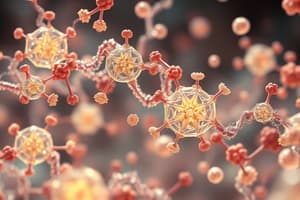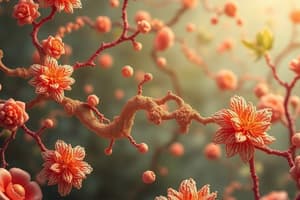Podcast
Questions and Answers
Which of the following best describes the role of catabolic pathways in cellular metabolism?
Which of the following best describes the role of catabolic pathways in cellular metabolism?
- They break down complex molecules into simpler ones, releasing energy and providing building blocks. (correct)
- They transport molecules across cell membranes, regulating cellular osmotic balance.
- They replicate DNA and transcribe RNA, ensuring genetic information is accurately passed on.
- They synthesize complex molecules from simpler precursors, requiring energy input.
In the context of enzyme kinetics, how does a competitive inhibitor affect the Michaelis-Menten equation?
In the context of enzyme kinetics, how does a competitive inhibitor affect the Michaelis-Menten equation?
- It decreases the $V_{max}$ and increases the $K_m$.
- It does not affect the $V_{max}$, but increases the $K_m$. (correct)
- It decreases both the $V_{max}$ and the $K_m$.
- It increases the $V_{max}$ and decreases the $K_m$.
Which statement accurately describes the role and significance of the central dogma of molecular biology?
Which statement accurately describes the role and significance of the central dogma of molecular biology?
- It details how mutations in RNA are directly translated back into DNA, correcting genetic errors.
- It outlines the flow of genetic information from protein to RNA to DNA, enabling cellular adaptation.
- It explains the process by which proteins directly replicate themselves to preserve genetic information.
- It describes the flow of genetic information from DNA to RNA to protein, essential for gene expression. (correct)
In the context of bioenergetics, what is the significance of coupling an exergonic reaction with an endergonic reaction in a biological system?
In the context of bioenergetics, what is the significance of coupling an exergonic reaction with an endergonic reaction in a biological system?
How does the presence of multiple carbon-carbon double bonds in unsaturated fatty acids affect their physical properties and biological roles?
How does the presence of multiple carbon-carbon double bonds in unsaturated fatty acids affect their physical properties and biological roles?
How do allosteric enzymes differ from Michaelis-Menten enzymes in terms of regulation and kinetics?
How do allosteric enzymes differ from Michaelis-Menten enzymes in terms of regulation and kinetics?
What is the role of GTP hydrolysis in the function of G proteins during signal transduction, and how does it contribute to the overall signaling process?
What is the role of GTP hydrolysis in the function of G proteins during signal transduction, and how does it contribute to the overall signaling process?
Why is the induced fit model now favored over the lock-and-key model for enzyme-substrate interactions?
Why is the induced fit model now favored over the lock-and-key model for enzyme-substrate interactions?
How does the structure of glycogen contribute to its function as a storage form of glucose in animals?
How does the structure of glycogen contribute to its function as a storage form of glucose in animals?
How does the unique structure of phospholipids enable them to form biological membranes, and what properties emerge from this arrangement?
How does the unique structure of phospholipids enable them to form biological membranes, and what properties emerge from this arrangement?
What is the significance of the quaternary structure of proteins, and how does it influence their biological functions?
What is the significance of the quaternary structure of proteins, and how does it influence their biological functions?
How do regulatory T cells (Tregs) suppress excessive immune responses, and what are the implications of their dysfunction in autoimmune diseases?
How do regulatory T cells (Tregs) suppress excessive immune responses, and what are the implications of their dysfunction in autoimmune diseases?
How does the process of alternative splicing contribute to proteomic diversity in eukaryotic cells?
How does the process of alternative splicing contribute to proteomic diversity in eukaryotic cells?
How does the structure of DNA polymerase contribute to its high fidelity during DNA replication?
How does the structure of DNA polymerase contribute to its high fidelity during DNA replication?
What is the role of chaperones in protein folding, and how do they prevent protein aggregation and misfolding?
What is the role of chaperones in protein folding, and how do they prevent protein aggregation and misfolding?
In the context of genetics, what are epigenetic modifications, and how do they influence gene expression without altering the DNA sequence?
In the context of genetics, what are epigenetic modifications, and how do they influence gene expression without altering the DNA sequence?
How does the CRISPR-Cas9 system function as a tool for genome editing, and what are its key components and mechanisms?
How does the CRISPR-Cas9 system function as a tool for genome editing, and what are its key components and mechanisms?
How do receptor tyrosine kinases (RTKs) initiate intracellular signaling cascades upon ligand binding, and what are the key steps in this process?
How do receptor tyrosine kinases (RTKs) initiate intracellular signaling cascades upon ligand binding, and what are the key steps in this process?
How does the process of ubiquitination regulate protein turnover, and what are the different types of ubiquitination?
How does the process of ubiquitination regulate protein turnover, and what are the different types of ubiquitination?
What role do heat shock proteins (HSPs) play in cellular stress response, and how do they protect cells from damage under adverse conditions?
What role do heat shock proteins (HSPs) play in cellular stress response, and how do they protect cells from damage under adverse conditions?
Flashcards
Biochemistry
Biochemistry
The branch of science that explores chemical processes within living organisms, combining biology and chemistry to investigate molecular interactions in biological systems.
Carbohydrates
Carbohydrates
Organic compounds containing carbon, hydrogen, and oxygen, serving as a primary energy source.
Monosaccharides
Monosaccharides
Simple sugars like glucose and fructose.
Disaccharides
Disaccharides
Signup and view all the flashcards
Polysaccharides
Polysaccharides
Signup and view all the flashcards
Lipids
Lipids
Signup and view all the flashcards
Triglycerides
Triglycerides
Signup and view all the flashcards
Saturated fatty acids
Saturated fatty acids
Signup and view all the flashcards
Unsaturated fatty acids
Unsaturated fatty acids
Signup and view all the flashcards
Phospholipids
Phospholipids
Signup and view all the flashcards
Proteins
Proteins
Signup and view all the flashcards
Amino acids
Amino acids
Signup and view all the flashcards
Primary structure
Primary structure
Signup and view all the flashcards
Secondary structure
Secondary structure
Signup and view all the flashcards
Nucleic acids
Nucleic acids
Signup and view all the flashcards
DNA
DNA
Signup and view all the flashcards
RNA
RNA
Signup and view all the flashcards
Metabolism
Metabolism
Signup and view all the flashcards
Activation energy
Activation energy
Signup and view all the flashcards
Bioenergetics
Bioenergetics
Signup and view all the flashcards
Study Notes
- Biochemistry is a branch of science exploring the chemical processes within and relating to living organisms.
- It combines biology and chemistry to investigate the composition, reactions, and molecular interactions in biological systems.
- Biochemistry seeks to explain biological processes at the molecular level.
Core Concepts
- Biomolecules: The major classes include carbohydrates, lipids, proteins, and nucleic acids.
- Metabolism: Encompasses all chemical reactions that occur in an organism, including catabolism (breakdown) and anabolism (synthesis).
- Enzymes: Biological catalysts that accelerate chemical reactions in living organisms.
- Bioenergetics: The study of energy flow through living systems.
- Genetics: The study of heredity and the variation of inherited characteristics.
Biomolecules: Carbohydrates
- Carbohydrates are organic compounds containing carbon, hydrogen, and oxygen, generally in a 1:2:1 ratio.
- They serve as a primary source of energy for living organisms.
- Monosaccharides: Simple sugars such as glucose, fructose, and galactose.
- Disaccharides: Formed by the joining of two monosaccharides, e.g., sucrose (glucose + fructose) and lactose (glucose + galactose).
- Polysaccharides: Complex carbohydrates consisting of many monosaccharide units, e.g., starch, glycogen, and cellulose.
- Starch is a storage form of glucose in plants.
- Glycogen is a storage form of glucose in animals.
- Cellulose provides structural support in plant cell walls.
Biomolecules: Lipids
- Lipids are hydrophobic or amphipathic molecules, including fats, oils, phospholipids, and steroids.
- They are essential for energy storage, cell membrane structure, and hormone signaling.
- Triglycerides: Composed of a glycerol molecule esterified with three fatty acids.
- Saturated fatty acids: Contain no carbon-carbon double bonds and are typically solid at room temperature.
- Unsaturated fatty acids: Contain one or more carbon-carbon double bonds and are typically liquid at room temperature.
- Phospholipids: Major components of cell membranes, composed of a glycerol backbone, two fatty acids, and a phosphate group.
- Steroids: Characterized by a four-ring structure, e.g., cholesterol, testosterone, and estrogen.
Biomolecules: Proteins
- Proteins are complex macromolecules composed of amino acids linked by peptide bonds.
- They perform a wide variety of functions, including catalysis, transport, structural support, and immune defense.
- Amino acids: The building blocks of proteins, each containing an amino group, a carboxyl group, and a side chain (R group).
- Primary structure: The linear sequence of amino acids in a protein.
- Secondary structure: Local folding patterns, such as alpha-helices and beta-sheets, stabilized by hydrogen bonds.
- Tertiary structure: The overall three-dimensional structure of a protein, stabilized by various interactions (e.g., hydrophobic interactions, disulfide bonds).
- Quaternary structure: The arrangement of multiple polypeptide chains in a multi-subunit protein.
- Enzymes are proteins that catalyze biochemical reactions by lowering the activation energy.
- Antibodies are proteins that recognize and bind to specific antigens, providing immunity.
Biomolecules: Nucleic Acids
- Nucleic acids are polymers of nucleotides involved in storing and transmitting genetic information.
- DNA (deoxyribonucleic acid): Contains the genetic instructions for the development and function of living organisms.
- RNA (ribonucleic acid): Involved in various cellular processes, including protein synthesis and gene regulation.
- Nucleotides: Composed of a nitrogenous base, a pentose sugar (deoxyribose in DNA, ribose in RNA), and one or more phosphate groups.
- Nitrogenous bases: Adenine (A), guanine (G), cytosine (C), thymine (T) in DNA; uracil (U) replaces thymine in RNA.
- DNA structure: A double helix consisting of two strands held together by hydrogen bonds between complementary base pairs (A-T, G-C).
- RNA structure: Usually single-stranded, but can form complex secondary and tertiary structures.
Metabolism
- Metabolism is the sum of all chemical reactions occurring in an organism.
- Catabolism: The breakdown of complex molecules into simpler ones, releasing energy (e.g., cellular respiration).
- Anabolism: The synthesis of complex molecules from simpler ones, requiring energy (e.g., photosynthesis).
- Metabolic pathways: Sequences of enzyme-catalyzed reactions that convert specific reactants into specific products.
- Glycolysis: The breakdown of glucose into pyruvate, producing ATP and NADH.
- Citric acid cycle (Krebs cycle): A series of reactions that oxidize acetyl-CoA, producing ATP, NADH, and FADH2.
- Oxidative phosphorylation: The process by which ATP is synthesized using the energy from the electron transport chain.
- Photosynthesis: The process by which plants convert light energy into chemical energy in the form of glucose.
- Gluconeogenesis: The synthesis of glucose from non-carbohydrate precursors.
Enzymes
- Enzymes are biological catalysts that accelerate chemical reactions by lowering the activation energy.
- Active site: The region of an enzyme where the substrate binds and the reaction occurs.
- Substrate: The molecule upon which an enzyme acts.
- Cofactors: Non-protein molecules or ions that are required for enzyme activity (e.g., metal ions, coenzymes).
- Coenzymes: Organic cofactors (e.g., vitamins).
- Enzyme specificity: Enzymes are highly specific for their substrates.
- Enzyme kinetics: The study of the rates of enzyme-catalyzed reactions.
- Michaelis-Menten kinetics: A model describing the relationship between enzyme activity and substrate concentration.
- Enzyme inhibition: Molecules that reduce enzyme activity (e.g., competitive inhibitors, non-competitive inhibitors).
- Allosteric regulation: The regulation of enzyme activity by the binding of molecules to sites other than the active site.
Bioenergetics
- Bioenergetics is the study of energy flow through living systems.
- Thermodynamics: The study of energy and its transformations.
- First law of thermodynamics: Energy cannot be created or destroyed, only converted from one form to another.
- Second law of thermodynamics: The entropy (disorder) of an isolated system always increases.
- Gibbs free energy (G): A measure of the energy available to do work in a chemical or physical system.
- Exergonic reactions: Reactions that release energy (negative ΔG).
- Endergonic reactions: Reactions that require energy (positive ΔG).
- ATP (adenosine triphosphate): The primary energy currency of the cell.
- ATP hydrolysis: The breakdown of ATP into ADP and inorganic phosphate, releasing energy.
- Coupled reactions: The use of energy from an exergonic reaction to drive an endergonic reaction.
Genetics
- Genetics is the study of heredity and the variation of inherited characteristics.
- Genes: Units of heredity that contain the instructions for making proteins.
- Genome: The complete set of genetic information in an organism.
- DNA replication: The process by which DNA is copied.
- Transcription: The process by which RNA is synthesized from a DNA template.
- Translation: The process by which proteins are synthesized from RNA.
- Central dogma of molecular biology: DNA -> RNA -> Protein.
- Mutations: Changes in the DNA sequence that can lead to altered protein function.
- Gene regulation: The control of gene expression, determining when and where genes are transcribed and translated.
- Recombinant DNA technology: Techniques for manipulating and combining DNA from different sources.
- Polymerase chain reaction (PCR): A technique for amplifying specific DNA sequences.
- DNA sequencing: Determining the nucleotide sequence of a DNA molecule.
Studying That Suits You
Use AI to generate personalized quizzes and flashcards to suit your learning preferences.




